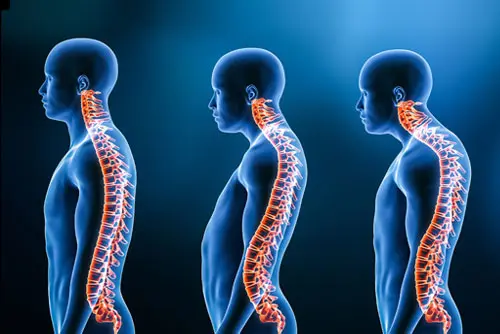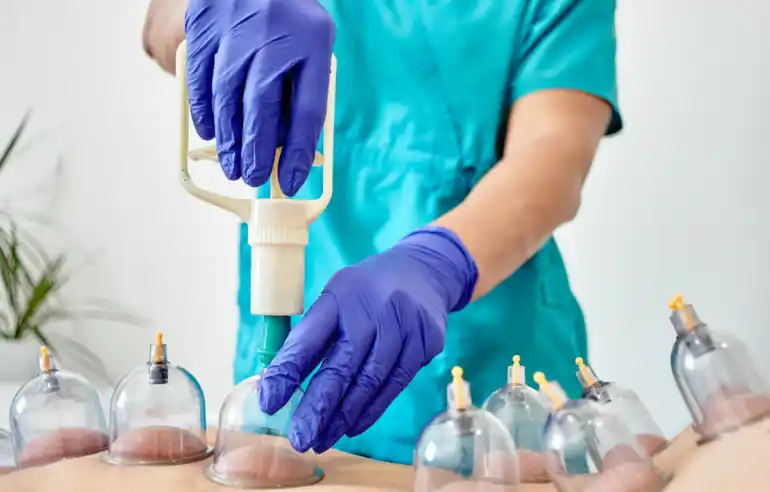Overview
Gibbus deformity is a structural spinal deformity characterized by a sharp, angular curvature of the thoracic or thoracolumbar spine, resulting in a prominent hump-like appearance on the back. Unlike a smooth kyphosis, which produces a gentle curve, a Gibbus deformity is defined by an abrupt, localized angulation, typically caused by the collapse of one or more vertebral bodies. This deformity most commonly affects the thoracic spine and is often associated with underlying conditions such as tuberculosis of the spine (Pott’s disease), congenital vertebral malformations, or traumatic vertebral fractures.
This deformity not only alters physical appearance but can also severely impact posture, respiratory function, and spinal stability. The severity of Gibbus deformity depends on the degree of vertebral collapse and the underlying pathology.
At DMPhysios, a leading clinic in Noida specializing in spine and sports conditions with a patient-centered rehabilitation approach, comprehensive management of Gibbus deformity includes advanced physiotherapy assessment, corrective postural exercises, and spinal strengthening to restore function, reduce pain, and improve quality of life.
Symptoms
The symptoms of Gibbus deformity can vary depending on the cause and severity of the spinal angulation. Some patients may present primarily with cosmetic concerns, while others experience significant pain or neurological symptoms due to spinal cord compression. Common symptoms include:
- Visible Hump on the Back:
A distinct, sharp, angular protrusion of the upper or mid-back region, noticeable when the person bends forward. - Back Pain and Stiffness:
Chronic or intermittent pain in the affected spinal region due to vertebral collapse and muscle imbalance. - Restricted Mobility:
Decreased range of motion in the thoracic or lumbar spine, leading to difficulty bending, twisting, or maintaining an upright posture. - Neurological Symptoms:
In severe cases, spinal cord compression may cause numbness, tingling, weakness, or even paralysis of the lower limbs. - Respiratory or Cardiovascular Compromise:
If the deformity involves the thoracic spine, lung expansion can be restricted, leading to shortness of breath or decreased endurance. - Altered Posture and Gait:
Forward stooping posture, imbalance, and compensatory spinal curvature are common secondary effects of Gibbus deformity. - Fatigue and Reduced Functional Capacity:
The extra muscular effort required to maintain posture often leads to fatigue during daily activities.
Types of Gibbus Deformity
While Gibbus deformity is generally classified based on its cause and location, it can be divided into the following main types:
- Congenital Gibbus Deformity:
Caused by structural abnormalities during spinal development, such as hemivertebrae or vertebral segmentation defects. - Infectious Gibbus Deformity:
Most commonly due to spinal tuberculosis (Pott’s disease), which leads to vertebral body collapse and sharp angulation. - Post-Traumatic Gibbus Deformity:
Occurs after vertebral fractures or compression injuries, often following road accidents or falls. - Post-Surgical or Iatrogenic Gibbus Deformity:
May develop after spinal surgeries or laminectomies where improper healing leads to vertebral collapse. - Degenerative or Osteoporotic Gibbus Deformity:
Seen in older adults due to bone loss and vertebral compression fractures related to osteoporosis.
Causes
The underlying causes of Gibbus deformity vary, but they all involve structural damage or abnormal development of the vertebral column. Common causes include:
- Spinal Tuberculosis (Pott’s Disease):
One of the most frequent causes in developing countries, where infection destroys the vertebral bodies, leading to collapse and angulation. - Congenital Vertebral Malformations:
Developmental anomalies during fetal growth cause wedge-shaped vertebrae that produce abnormal curvature. - Trauma or Vertebral Fractures:
Sudden compression or collapse of vertebral segments due to high-impact injuries - Osteoporosis:
In elderly individuals, bone weakening can cause multiple compression fractures resulting in deformity. - Tumors and Metastatic Disease:
Destructive lesions in the spine can compromise bone strength and lead to Gibbus deformity. - Post-Infectious or Post-Surgical Changes:
Scarring or vertebral instability after infection or surgery may contribute to spinal collapse.
Risk Factors
Several factors increase the likelihood of developing Gibbus deformity, including:
- Chronic tuberculosis infection
- Congenital skeletal abnormalities
- Osteoporosis and bone mineral loss
- Poor posture during growth years
- Spinal injuries or trauma
- Delayed diagnosis of spinal infections
- Nutritional deficiencies (especially Vitamin D and calcium)
- Inadequate treatment of spinal diseases
Individuals with these risk factors should undergo early screening and intervention to prevent progression of Gibbus deformity.
Treatment of Gibbus Deformity
The management of Gibbus deformity depends on its cause, severity, and impact on neurological and functional status. Treatment may involve medical, surgical, and physiotherapeutic approaches.
1. Medical Treatment
- Anti-tubercular Therapy (ATT):
For cases caused by spinal tuberculosis, prolonged antibiotic therapy (6–12 months) is essential to eradicate infection. - Pain Management:
Nonsteroidal anti-inflammatory drugs (NSAIDs) or analgesics help control pain and inflammation. - Bone Health Supplements:
Calcium, Vitamin D, and bisphosphonates may be prescribed to improve bone strength. - Bracing:
Spinal braces or orthoses help support posture, reduce deformity progression, and relieve pain.
2. Surgical Treatment
Surgical correction is indicated when Gibbus deformity causes severe spinal cord compression, progressive deformity, or intractable pain. Surgical procedures may include:
- Spinal Decompression:
Removal of pressure on the spinal cord. - Spinal Fusion and Instrumentation:
Stabilizing the affected vertebrae with rods and screws to correct deformity. - Vertebral Reconstruction or Osteotomy:
Surgical realignment of the spinal column in severe or complex cases.
However, post-surgical rehabilitation is crucial to restore mobility and function, an area where DMPhysios, Noida excels through structured and patient-centered physiotherapy programs.
Physiotherapy Treatment
Physiotherapy plays a pivotal role in managing Gibbus deformity, both before and after surgery. At DMPhysios, a trusted spine and sports rehabilitation clinic in Noida, physiotherapy is designed to restore spinal mobility, enhance muscular strength, and improve posture alignment through evidence-based, individualized treatment.
1. Initial Assessment
Physiotherapists at DMPhysios perform a comprehensive evaluation, including:
- Postural analysis
- Range of motion assessment
- Muscle strength testing
- Neurological screening (for nerve compression symptoms)
- Functional and gait analysis
2. Pain Management Techniques
- Thermotherapy and Cryotherapy:
Heat therapy to relax tight muscles and ice therapy to reduce inflammation. - Accelerated Healing Therapy or TENS:
To relieve pain, promote tissue healing, and improve circulation.
3. Postural Correction Exercises
- Spinal Extension Exercises:
Techniques like prone press-ups and McKenzie extensions help counteract kyphotic curvature. - Shoulder Retraction Exercises:
Strengthening rhomboids and trapezius to improve upper back posture. - Wall Angels and Chin Tucks:
To align the spine and reduce compensatory forward head posture.
4. Strengthening Exercises
- Back Extensors Strengthening:
Targeting erector spinae, multifidus, and other stabilizers of the spine. - Core Stabilization:
Engaging deep abdominal and pelvic muscles to enhance spinal support. - Gluteal and Hamstring Strengthening:
To support the posterior chain and improve spinal alignment.
5. Stretching Exercises
- Pectoral and Anterior Shoulder Stretching:
To open up the chest and prevent rounded shoulders. - Hip Flexor and Hamstring Stretching:
To maintain balance between anterior and posterior muscles.
6. Breathing and Respiratory Exercises
Given that Gibbus deformity can restrict thoracic expansion, respiratory physiotherapy is critical:
- Diaphragmatic Breathing
- Chest Expansion Exercises
- Segmental Breathing
These improve lung capacity and oxygen exchange efficiency.
7. Functional Rehabilitation
- Gait Training:
To correct compensatory walking patterns. - Balance and Proprioception Training:
Using stability balls and balance boards to enhance spinal control. - Post-Surgical Rehabilitation:
Gradual mobilization, scar tissue management, and strengthening post spinal correction surgery.
8. Ergonomic and Lifestyle Advice
At DMPhysios, patients receive customized guidance for:
- Proper sitting and standing posture
- Ergonomic workstation setup
- Safe lifting techniques
- Home exercise programs for long-term maintenance
This holistic, patient-focused approach distinguishes DMPhysios as a leader in spine rehabilitation and recovery for conditions like Gibbus deformity.
Prevention
While some forms of Gibbus deformity (especially congenital types) cannot be completely prevented, early diagnosis and proper management can significantly reduce progression. Preventive measures include:
- Early Treatment of Spinal Infections:
Prompt management of tuberculosis or bacterial infections prevents vertebral destruction. - Spinal Health During Growth:
Regular posture checks in children and adolescents to detect spinal curvature early. - Bone Health Maintenance:
Adequate intake of calcium, vitamin D, and regular weight-bearing exercise to prevent osteoporosis. - Safe Movement and Injury Prevention:
Practicing safe lifting techniques and avoiding high-impact trauma. - Regular Physiotherapy Check-ups:
Consulting a spine specialist clinic like DMPhysios for early evaluation, especially in individuals with back pain, poor posture, or spinal abnormalities.
Conclusion
Gibbus deformity is a serious spinal condition that affects not only physical appearance but also posture, function, and overall quality of life. With early diagnosis, medical management, and a comprehensive physiotherapy program, most patients can achieve significant improvement in posture, pain reduction, and functional mobility.
At DMPhysios, a renowned physiotherapy clinic in Noida specializing in spine and sports conditions, the focus is on patient-centered rehabilitation, blending evidence-based physiotherapy techniques, modern modalities, and personalized care to help individuals regain confidence and live pain-free.
If you or a loved one is struggling with Gibbus deformity or any spinal abnormality, don’t delay expert intervention.
Visit DMPhysios in Noida today for specialized spinal assessment, personalized physiotherapy, and holistic rehabilitation tailored to your needs.









